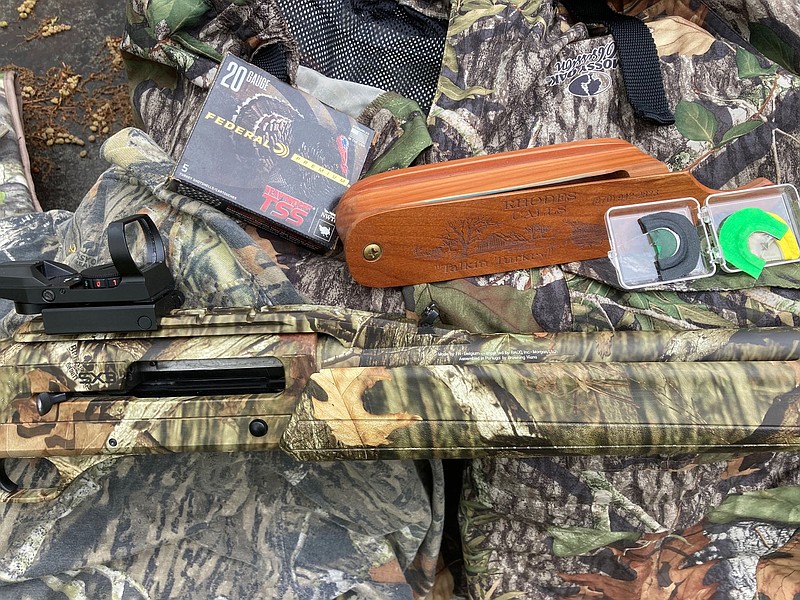Spring turkey season starts Monday, and hopefully you have a place to hunt, and maybe even a partner with which to hunt.
Do you have all the gear you need? Probably not, because turkey hunters never really have all the gear they need.
Let's make a checklist.
Clothing
Before turkey hunting became a big business, many hunters killed a lot of turkeys wearing blue denim overalls and feed mill ballcaps without face coverings. A recent article speculated that since blue is the color of a hen turkey's head, that turkeys are either attracted to blue or at least not alarmed by blue.
Rather than debate turkey psychology, it's much easier to elude a turkey's keen eyesight by blending into the surroundings. If you blow a hunt, at least you can't blame it on your attire.
For spring hunting in Arkansas, clothing with a leafy camouflage pattern blends with hardwood forests in bloom. You can also get pine patterns for hunting in piney woods, but leaf patterns work well for me. I also wear a long-sleeve shirt with a woodland camo pattern. Camouflage overalls are versatile, but I prefer trousers.
Gloves are important because your hands move when turkey hunting, and turkeys see movement. Camo mesh gloves are fine, but cheap black, cotton gloves work well, too.
There are all kinds of face coverings. I have tried a great many, but my favorite is a camo ballcap with a face covering sewn into the cap. I also like a mesh net that attaches to the cap with Velcro. When you're not working a gobbler, you can pull the mesh over the cap's bill.
Footwear
Having been bitten by a timber rattlesnake, I am highly dedicated to avoiding a repeat, so I wear knee-high, camouflage snake boots. My favorite is the MudTrek from Irish Setter. Its ratcheting cable "lacing" system allows you to fasten them looser than with traditional laces, making it easier and more comfortable to stuff your pant legs inside.
Insect repellent
Ticks are an unfortunate reality of spring turkey hunting. At least two days before hunting, spray your hunting clothes and boots thoroughly with the highest concentration of DEET available. Permanone was the best tick deterrent I ever used. Repel Clothing and Gear is also very good.
Dry the garments by hanging them on a fence or a line. It works very well, but you will have to reapply the repellent if you wash the garments. Do not spray high concentrations of DEET on your skin.
Use a milder repellent, like Deep Woods OFF, to deter mosquitoes and gnats on skin. These pests have a nasty habit of showing up and biting when you're working a gobbler. Swatting or flinching will ruin your hunt. I use OFF! Botanicals and Repel Insect Repellent, which do not contain harsh chemicals.
Eye wear
Heaven forbid any of us being involved in a hunting accident, but the sneaky, stealthy nature of turkey hunting accelerates the risk. High-quality, anti-ballistic sunglasses will preserve your eyes if you are a victim of an accidental shooting. Oakley is the best. Its lenses are made to withstand a shotgun blast, which is why they are so popular with military personnel.
I prefer copper-colored lenses, which intensify brightness in the woods at dawn and drastically reduce glare throughout the rest of the day. They also accentuate the colors in a turkey's plumage, allowing you to distinguish a turkey in cover easier than with bare eyes. They enable you to clearly see turkeys in brush who might elude unaided eyes.
Callers
I carry a lot of calls, but really, you only need two. A diaphragm suffices for 90% of all turkey hunting situations, but there are times when you need the volume of a friction call. I love box calls, with a distinct preference for those made by Eddie Horton of Camden and Bill Rhodes of Sheridan. I also like slate calls made by David Taylor of Sheridan and the Premium Game Calls Diamond Cutter made in Dierks.
Rhodes says that a simple cedar box call works well in any Arkansas environment, and that a walnut call is almost as useful. I have several dozen box calls, and I use them all, mainly because I like them.
For diaphragms, you can't go wrong with Premium Game Calls, Woodhaven, Primos or H.S. Strut. You'll get different tones and timbres with bat wing, single reed, double reed and even triple reed. Buy a selection. The one that's easiest to blow will be your first choice.
You will also want to trim the skirt to fit your mouth. The call should rest fairly flush against the roof, and it should make sounds with minimum effort.
A simple cluck, purr and yelp will suffice for most situations.
Shotgun/payload
Adroit hunters already have patterned a turkey hunting load through their shotguns to deliver a lethal pattern to 40 yards.
Thanks to modern projectiles such as tungsten super shot and Hevi-Shot, a 20-gauge shotgun is equal or superior to standard 12-gauge ballistics with lead shot. In fact, many turkey hunters now use 28-gauge and .410-caliber shotguns for turkey hunting with outstanding success.
It is crucial to pattern a specific load to a specific gun with a specific choke. When you get the pattern you want, do not change a component.
Improved sights are also helpful. I used Truglo fiber-optic sights on my 12-gauge for years with outstanding results. This year I switched to a Winchester SX3 20-gauge with an electronic Truglo dot sight. I am very happy with its performance, but a battery-powered implement can fail. If you use an electronic sight, always carry an extra battery.
Finally, be safe. Positively identify your target as a mature gobbler before shooting. Don't shoot at sound and don't guess at a gobbler's legality. It's better to let a gobbler walk than to gamble and risk shooting an immature gobbler.
Make the experience memorable for all the right reasons.
